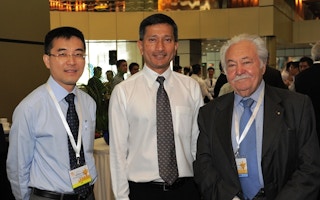Singapore’s new Minister for the Environment and Water Resources, Dr Vivian Balakrishnan, kicked off the country’s first national energy efficiency conference yesterday, telling 200 industry leaders they were crucial to tackling Singapore’s carbon emissions, and that the government was ready to help.
“We will put our money where our mouth is,” he said as he announced increased funding for Singapore’s energy efficiency co-funding scheme.
The Grant for Energy Efficiency Technologies (GREET) is a S$22 million incentive programme launched in 2008 to increase industry investment in energy efficiency technologies. Funds for GREET, which has so far resulted in an expected life-time energy savings of more than S$160 million and a yearly reduction in carbon emissions of more than 40 kilotonnes, are expected to run out this year – one year ahead of schedule. To encourage further uptake of the programme, the National Environment Agency (NEA) has secured additional funding for the next two years and raised the cap on individual grants from S$2 million to S$4 million.
GREET is managed by the National Energy Efficiency Partnership (EENP), an initiative developed in response to Singapore’s goal of reaching a 35 per cent reduction in its energy intensity, or energy expended per unit of GDP, from 2005 levels by 2030.
In his opening address, Dr Balakrishnan stressed the importance of improving Singapore’s energy efficiency in light of its limited size and resources for developing renewable energy. He said our carbon footprint is always going to be an issue in Singapore. “Go for the big, low-hanging fruit first,” he added.
Consuming nearly 60 per cent of the nation’s energy, the industry sector is one of the government’s picks for low-hanging fruit. Under the Energy Conservation Act, which will take effect in 2013, industries using large amounts of energy will have to employ energy managers to measure energy use and develop plans for improving energy efficiency.
The EENP is charged with helping industries prepare for these requirements with training and opportunities for sharing knowledge about energy efficiency methods within specific fields.
One of those opportunities is this week’s National Energy Efficiency Conference 2011 at the Singapore Convention Centre, co-organised by EENP’s government agency founders – the National Environment Agency (NEA), The Economic Development Board (EDB) and the Energy Market Authority (EMA). Attending the two-day conference are representatives from many of EENP’s 96 members, including multi-national corporations ST Microelectronics, HP Asia Pacific, IBM, Schneider Electric and McKinsey & Company.
NEA chief executive Andrew Tan said he would like more partners to incorporate energy efficiency as part of their industrial practices, set in-house energy performance goals and track their performance over time. “Overseas experiences suggest that companies (with energy management systems in place) can typically expect to reduce their energy consumption by at least 10 to 15 per cent during the first year of implementation,” he added.
Mr Tan said recent efforts by the EENP have focused on specific energy intensive sectors such as data centres, chemicals and pharmaceuticals. In addition to networking with local and international experts on improving energy management efforts, EENP is providing training to industry professionals throughout Southeast Asia through its Asean Energy Managers Accreditation Scheme (AEMAS).
Keynote speaker Pasquale Pistorio, a long-time environmental champion and former chief executive of European semiconductor manufacturer ST Microelectronics, stressed the importance of energy efficiency to Singapore and its industries.
He said the fossil fuels that supported the industrial revolution have left the world with “big burdens and big uncertainty,” adding that energy efficiency was the most cost effective solution to the problem.
“Energy saving is cheap,” said Mr Pistorio as he called on businesses to provide good examples of the effectiveness of energy efficiency. He provided his own example of a USD300 million investment by ST Microelectronics that saved the company USD900 million in a ten year time frame.
But government must do its part, he continued, by providing incentives, enacting regulations and educating the public on the benefits of energy efficiency.
Singapore’s government has prioritised energy efficiency as their key strategy to tackle carbon emissions, according to Dr Balakrishnan. He said the government must make sure the lessons learned through the EENP’s network were not just single company experiments, but lessons that improve the entire system to ensure the national goals are reached.
“We are on target, but we’re not there yet,” he said.

















